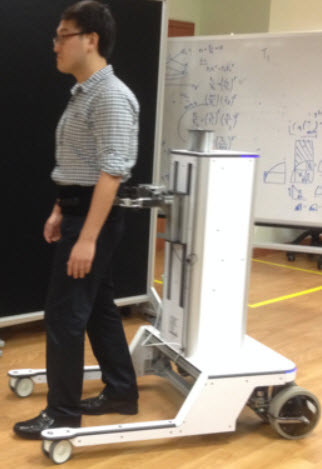Robotic walker helps patients regain natural gait and increases productivity of physiotherapists
November 21, 2014

Robotic walker (credit: NUS)
A novel robotic walker that helps patients carry out therapy sessions to regain their leg movements and natural gait has been invented by a team of researchers led by assistant professor Yu Haoyong from the National University of Singapore Department of Biomedical Engineering.
Survivors of stroke or other neurological conditions such as spinal cord injuries, traumatic brain injuries and Parkinson’s disease often struggle with mobility. To regain their motor functions, these patients are required to undergo challenging physical therapy sessions.
The robotic walker is capable of supporting a patient’s weight while providing the right amount of force at the pelvis of the patient to help the patient walk with a natural gait.
The system also increases productivity of physiotherapists and improves the quality of rehabilitation sessions. Quantitative data can be collected during the therapy sessions to allow doctors and physiotherapists to monitor the progress of the patient’s rehabilitation.
How it works
The robotic walker comprises six modules:
- A suite of body sensors measure the gait of the patient so that the walker can provide the right amount of support to help the patient walk with a natural gait.
- The electrical stimulation unit can deliver targeted electrical current to stimulate the correct muscle at the correct timing to facilitate joint movement.
- The walker can provide assistive force, resistive force, and disturbance force depending on the training requirements set by the therapists, so, patients can go through different training schemes that are often difficult to achieve manually.
- The patient interacts with the walker through a force sensor which detects the user intent. The intelligent control system uses this information as well as the gait information provided by the body sensors to control the movement of the walker.
- The patient can practice gait movements by walking over ground instead of on a treadmill. Such features enable the gait training to be conducted in a natural and intuitive way.
- Gait kinematics and muscle activation pattern data allow for monitoring the progress of the patients’ recovery.
A robotic helper for physiotherapists
Besides improving the quality of rehabilitation sessions, the robotic walker will also relieve physiotherapists from the physical strain of assisting patients with the exercises.
Currently, gait training requires one or two physiotherapists to support the patient’s body weight and trunk, and an additional physiotherapist may be needed to move the paretic leg. Such therapy sessions are labor-intensive and ergonomically unfavorable for the physiotherapists, who often suffer from back injuries. This limits the quality, duration and frequency of rehabilitation sessions.
Haoyong is collaborating with spinoff Hope Technik to fine-tune and commercialize the robotic walker. He is also planning to conduct clinical studies to validate the training effects on patients and to develop novel therapy regimes together with clinicians at the National University Hospital.
“Our vision is for the robotic walker to be installed at outpatient clinics and rehabilitation centres to benefit patients who need therapy sessions. There is also a possibility that patients can perform exercises in the comfort of their own homes,” said Haoyong.